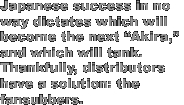by Len Cutler
|
Without the benefit of unlimited funds and massive market research data, anime distribution companies have been able to tap into a mass audience within a decade. How? These days, the value of good marketing cannot be overestimated. PR hacks the world over easily and gleefully recite a survey reporting that every dollar spent on marketing earns back three. It's the corporate mantra of the new economy: "If you hype it, they will buy."
Over time, the process has only grown more complex. Increased competition has driven everyone to up the ante, bidding desperately to keep up with the rising cacophony of unabashed consumerism. And with the advent of the Internet, it's hit a fever pitch. Now it's not enough for a company to tout its wares. If they want to make sales, executives have to know what works in advance; hit-or-miss advertising might work in localized markets, but in the global economy, the sheer volume of competing voices is such that the practice of blanket advertising has become just another way to flush a dot com down the dot commode. To turn a profit, it's crucial to know what the public wants in advance. Enter market research. The right information is akin to insider trading; with it producers and businesses try to project spending habits months, or even years, ahead of schedule. Consumer opinions and preferences can make or break a company, which is why, despite growing concerns about the erosion of online privacy, more and more companies have been turning to consumer information to bolster sales. The information won't harm anyone (at least, not directly), but it's nonetheless at the center of an extremely heated tug of war between industry and consumers; consumer information offers a veritable treasure trove of purchasing statistics, culled from a single source, cross-referenced against nearly every product imaginable. It's the Fort Knox of online spending information.
But as a glut of companies flood the arena, the means of gathering the data - focus groups, infomercial "special offers," Internet giveaways, and insipid telephone surveys - begin to lose efficiency as the disparate players clutter up the field. So just as the need for accurate information grows, the means of acquiring it grow ever scarcer. Success belongs to those companies that can predict, with a reasonable degree of accuracy, just what the pubic wants so that everything they try to sell, will. Most incredibly, though, sometimes the information is not only available, but it's free. That's the situation anime distributors have been working with over the last ten years. Given the sheer number of titles produced in Japan, US distributors are literally left having to pick titles randomly from a field of hundreds, and then sinking cash into having them translated, produced and disseminated. But Japanese success in no way dictates which will become the next "Akira," and which will tank. Thankfully, distributors have a solution: The fansubbers.
Since a precious few of Japan's animation titles are actually released to the international market, a grassroots community of translators, "fansubbers," have sprung up to pick up the slack, forming a virtual cottage industry of fans who aren't content to sit back and wait for new titles to make their way overseas. Instead, fansubbers do the work - translating, dubbing, and distributing tapes - on their own. They work long, tedious hours on expensive equipment that they've purchased with their own money, asking for nothing in return, other than an appreciation for the art they've worked so hard to share. |



